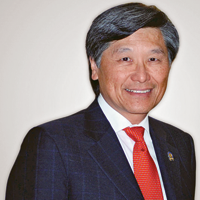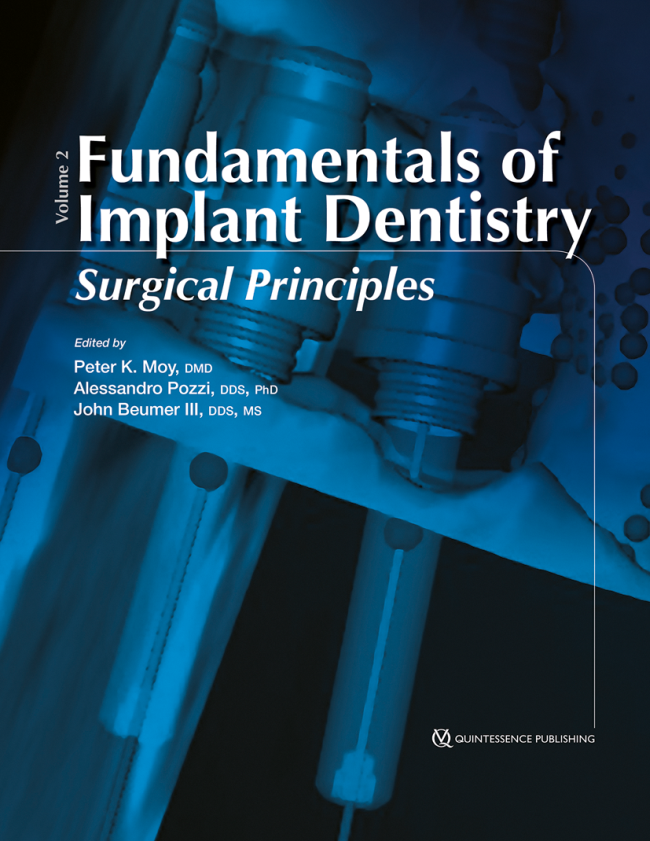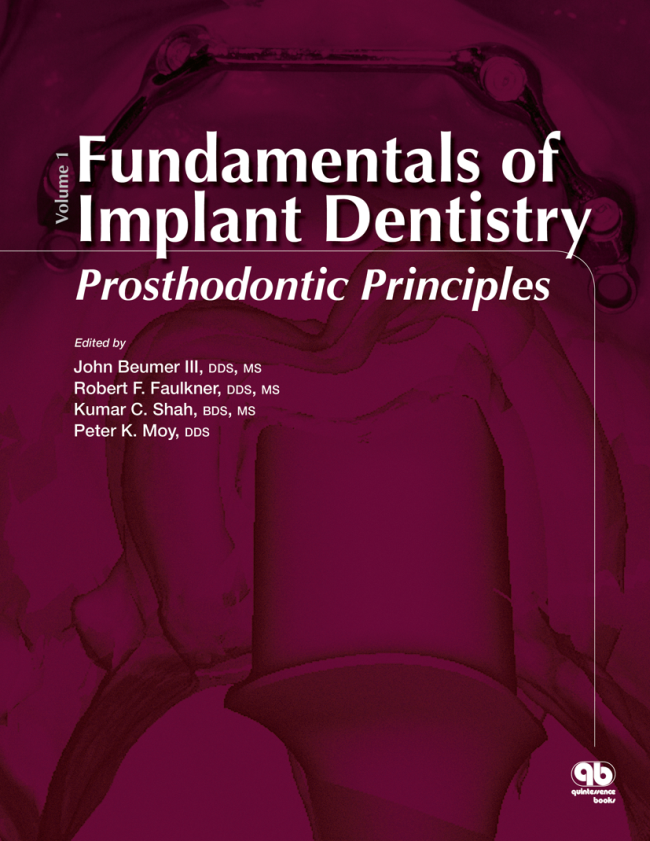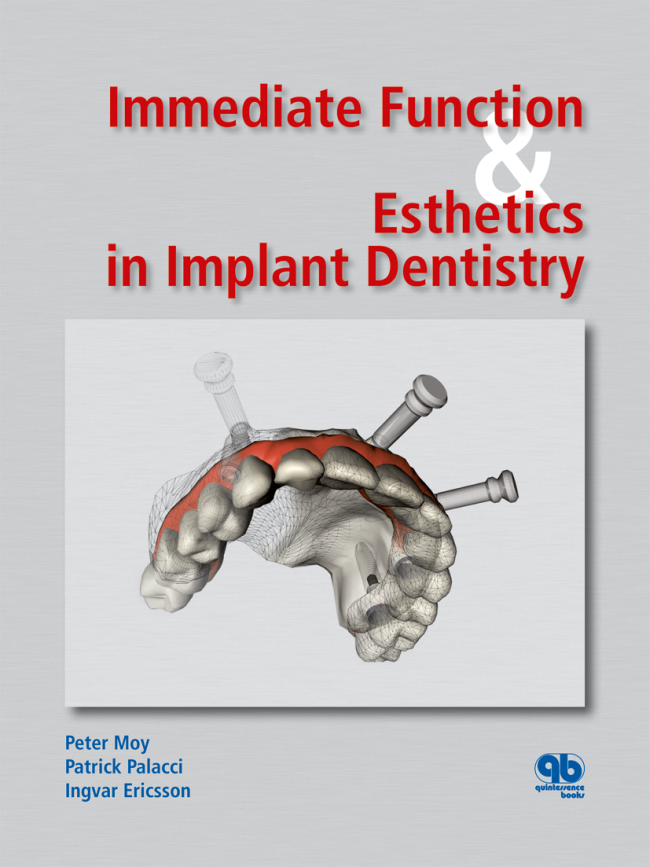International Journal of Oral Implantology, 5/2016
SupplementPubMed ID (PMID): 27314119Pages 135-153, Language: EnglishPozzi, Alessandro / Polizzi, Giovanni / Moy, Peter K.Aim: To systematically scrutinise the scientific literature to evaluate the accuracy of computer-guided implant placement for single missing teeth, as well as to analyse the eventual clinical advantages and treatment outcomes.
Material and methods: The electronic and manual literature search of clinical studies published from January 2002 up to November 2015 was carried out using specified indexing terms. Outcomes were accuracy; implant and prosthetic failures; biological and mechanical complications; marginal bone loss (MBL); sulcus bleeding index (SBI); plaque score (PS); pink esthetic score [PES]; aesthetic and clinical outcomes.
Results: The search yielded 1027 relevant titles and abstracts, found during the electronic (n = 1020) and manual (n = 7) searches. After data extraction, and screening of titles, abstracts, and full-texts, 32 studies fulfilled inclusion criteria and were included in the critical review: two randomised controlled clinical trials, six prospective observational single cohort studies, one retrospective observational study, three in vitro comparative studies, 10 case reports and 10 systematic reviews. A total of 209 patients (18 to 67 years old) were treated with 342 implants using computer-guided implant surgery. The follow-up ranged from 12 to 52 months. The cumulative survival rate ranged from 96.5% to 100%. Eleven implant planning softwares and guided surgery systems were used and evaluated.
Conclusions: Computer-guided surgery for single missing teeth provides comprehensive treatment planning, reliable implant positioning, favourable clinical outcomes and aesthetics. A tooth-supported template for the treatment of single missing teeth results in greater accuracy of implant positioning than with mucosa-supported or bone-supported templates. The limited scientific evidence available suggests that guided surgery leads to implant survival rates as good as conventional freehand protocols. Computer-guided surgery implies additional costs, that should be analysed in terms of cost-effectiveness, considering the reduction of surgery time, postoperative pain and swelling, as well as, the potential increased accuracy. Long-term randomised clinical trials are eagerly needed to investigate the clinical performance of guided surgery in partially edentate patients.
Keywords: computer-assisted surgery, computer guided surgery, single-tooth implant
International Journal of Oral Implantology, 5/2016
SupplementPubMed ID (PMID): 27314123Pages 163-172, Language: EnglishMoy, Peter K. / Nishimura, Grant H. / Pozzi, Alessandro / Danda, Anil K.Aim: This study evaluated the efficacy of replacing single missing teeth in the posterior quadrants of the maxilla and/or mandible with an implant-supported dental prosthesis.
Material and methods: Three scientific literature databases - Medline (Pubmed), Ovid Medline and Cochrane Central Register of Controlled Trials (CENTRAL) - were used to perform a search of publications over a period from 1985 to 2014. One hundred and forty one (141) articles were reviewed; 36 articles met the inclusion criteria and were included in the final review.
Results: The survival rates, success rates and mean bone loss for immediate implant placement were 96.9%, 100% and 0.85 mm, respectively. The survival rates, success rates and mean bone loss for delayed implant placement were 96.8%, 94.1% and 0.55 mm respectively. The survival rate, success rate and the mean bone loss in studies comparing immediate versus delayed implant placement showed 96.8% and 96.3%, 85.8% and 93.3%, and 0.57 ± 0.57 mm and 0.55 ± 0.37 mm, respectively.
Conclusion: The prognosis for single molar implants provides a viable treatment option for replacing a single missing tooth in the posterior quadrants of the maxilla and mandible. There does not appear to be a significant difference in the survival rates of immediately placed implants compared with delayed implant placement. However, the success rates were slightly higher with delayed loading protocols than immediate loading protocols.
Keywords: delayed loading, delayed placement, immediate loading, immediate placement, posterior quadrant, single implant
International Journal of Oral Implantology, 1/2015
PubMed ID (PMID): 25738179Pages 51-63, Language: EnglishPozzi, Alessandro / Tallarico, Marco / Moy, Peter K.Purpose: To evaluate the clinical and radiological performance of an immediately loaded novel implant design over a 3-year period.
Materials and methods: This prospective study includes 54 consecutive partially edentulous patients treated between December 2010 and October 2011. Outcome measures were: implant and prosthetic failures; biological and mechanical complications; marginal bone loss (MBL); sulcus bleeding index (SBI); and plaque score (PS).
Results: A total of 118 (29 narrow platform, 70 regular platform and 19 wide platform) NobelReplace Conical Connection implants were placed in both post-extraction sockets and healed sites and immediately loaded. The mean insertion torque was 63.4 ± 7.1 Ncm. One hundred out of 118 implants (84.7%) were inserted with a torque ranging between 55 and 70 Ncm. Each patient received a single prosthesis. At the 3-year follow-up, no patient dropped out and only two post-extractive implants failed (1.7%) in two patients (3.7%). The only complication (1.9%) observed was an event of periimplantitis, consisting of a mean mesiodistal peri-implant bone loss of 3.2 mm reported in a healed site of a smoker patient at the 2-year follow-up examination. No prosthesis failures were detected. The cumulative mean MBL between implant placements at the 3-year follow-up was 0.68 mm (95% CI: 0.44, 0.92). At the 3-year follow-up session, the SBI and PS were 5.7% and 15.4%, respectively.
Conclusions: The NobelReplace Conical Connection implant can be considered as a valuable treatment option for immediate implant placement and loading in the partially edentulous patients over a 3-year period. Insertion torques ranging between 55 and 70 Ncm are not detrimental to osseointegration.
Keywords: conical connection, dental implant, immediate loading, platform switching, postextractive
International Journal of Oral Implantology, 1/2014
PubMed ID (PMID): 24892113Pages 47-61, Language: EnglishPozzi, Alessandro / Tallarico, Marco / Moy, Peter K.Purpose: To compare the clinical and radiological outcomes of two implant designs with different prosthetic interfaces and neck configurations.
Materials and methods: Thirty-four partially edentate patients randomly received at least one NobelActive implant (Nobel Biocare, Göteborg, Sweden) with back-tapered collar, internal conical connection and platform shifting design, and one NobelSpeedy implant (Nobel Biocare) with external hexagon and flat-to-flat implant-abutment interface according to a split-mouth design. Follow-up continued to 3 years post-loading. The primary outcome measures were the success rates of the implants and prostheses, and the occurrence of any surgical and prosthetic complications during the entire follow-up. Secondary outcome measures were: horizontal and vertical peri-implant marginal bone level (MBL) changes, resonance frequency analysis values at implant placement and loading (4 months), sulcus bleeding index (SBI) and plaque score (PS).
Results: No drop-out occurred. No implants and prostheses failures were observed to the 3-year follow-up. MBL changes were statistically significant different with better results for the NobelActive implants for both horizontal and vertical measurements (P = 0.000). After 3 years post-loading, the NobelActive implants underwent a mean vertical bone resorption of 0.66 mm, compared with 1.25 mm for the NobelSpeedy Groovy implants (P = 0.000); the mean horizontal bone resorption was 0.19 mm for the NobelActive implants and 0.60 mm for the NobelSpeedy Groovy implants (P = 0.000). A high ISQ value was found for both implants, and no statistically significant difference was found for ISQ mean values between interventions (P = 0.941 at baseline; P = 0.454 at implantabutment connection; P = 0.120 at prosthesis delivery). All implants showed good periodontal health at the 3-year-in-function visit, with no significant differences between groups.
Conclusion: The results of this research suggest that in well-maintained patients, the MBL changes could be affected by the different implant design. After 4 months of unloaded healing, as well as after 3 years in function, both implants provided good results, however vertical and horizontal bone loss had statistically significant differences between the two groups (difference of 0.58 ± 0.10 mm for the vertical MBL, and 0.4 ± 0.05 mm for the horizontal MBL), with lower values in the Nobel Active implants, compared to the NobelSpeedy Groovy implants.
Keywords: bone level, bone loss, dental implants, platform shifting, implant-abutment interface
The International Journal of Oral & Maxillofacial Implants, 5/2009
PubMed ID (PMID): 19865615Pages 765, Language: EnglishMoy, Peter K.The International Journal of Oral & Maxillofacial Implants, 7/2007
SupplementPubMed ID (PMID): 18437791Pages 49-70, Language: EnglishAghaloo, Tara L. / Moy, Peter K.Purpose: A variety of techniques and materials have been used to establish the structural base of osseous tissue for supporting dental implants. The aim of this systematic review was to identify the most successful technique(s) to provide the necessary alveolar bone to place a dental implant and support long-term survival.
Methods: A systematic online review of a main database and manual search of relevant articles from refereed journals were performed between 1980 and 2005. Updates and additions were made from September 2004 to May 2005. The hard tissue augmentation techniques were separated into 2 anatomic sites, the maxillary sinus and alveolar ridge. Within the alveolar ridge augmentation technique, different surgical approaches were identified and categorized, including guided bone regeneration (GBR), onlay/veneer grafting (OVG), combinations of onlay, veneer, interpositional inlay grafting (COG), distraction osteogenesis (DO), ridge splitting (RS), free and vascularized autografts for discontinuity defects (DD), mandibular interpositional grafting (MI), and socket preservation (SP). All identified articles were evaluated and screened by 2 independent reviewers to meet strict inclusion criteria. Articles meeting the inclusion criteria were further evaluated for data extraction. The initial search identified a total of 526 articles from the electronic database and manual search. Of these, 335 articles met the inclusion criteria after a review of the titles and abstracts. From the 335 articles, further review of the full text of the articles produced 90 articles that provided sufficient data for extraction and analysis.
Results: For the maxillary sinus grafting (SG) technique, the results showed a total of 5,128 implants placed, with follow-up times ranging from 12 to 102 months. Implant survival was 92% for implants placed into autogenous and autogenous/composite grafts, 93.3% for implants placed into allogeneic/nonautogenous composite grafts, 81% for implants placed into alloplast and alloplast/xenograft materials, and 95.6% for implants placed into xenograft materials alone. For alveolar ridge augmentation, a total of 2,620 implants were placed, with follow-up ranging from 5 to 74 months. The implant survival rate was 95.5% for GBR, 90.4% for OVG, 94.7% for DO, and 83.8% for COG. Other techniques, such as DD, RS, SP, and MI, were difficult to analyze because of the small sample size and data heterogeneity within and across studies.
Conclusions: The maxillary sinus augmentation procedure has been well documented, and the long-term clinical success/survival (> 5 years) of implants placed, regardless of graft material(s) used, compares favorably to implants placed conventionally, with no grafting procedure, as reported in other systematic reviews. Alveolar ridge augmentation techniques do not have detailed documentation or long-term follow-up studies, with the exception of GBR. However, studies that met the inclusion criteria seemed to be comparable and yielded favorable results in supporting dental implants. The alveolar ridge augmentation procedures may be more technique- and operator-experience-sensitive, and implant survival may be a function of residual bone supporting the dental implant rather than grafted bone. More in-depth, long-term, multicenter studies are required to provide further insight into augmentation procedures to support dental implant survival.
Implantologie, 2/2007
Pages 179-193, Language: GermanWeinländer, Michael / Beumer III, John / Kenney, E. Barrie / Leković, Vojislav / Holmes, Ralph / Moy, Peter K. / Plenk, HannsDas Ziel der Studie bestand darin, den Einfluss von therapeutischer Bestrahlung auf die Knochenheilung im Bereich von drei enossalen Implantattypen bei Hunden zu untersuchen. Bei insgesamt sieben Hunden wurden zunächst alle Zähne aus dem rechten Unterkieferseitenbereich entfernt. Danach wurde dieser Bereich mit Implantaten versorgt, die unterschiedliche Oberflächen aufwiesen (Typ A = maschinengeglättete Schrauben aus handelsüblichem Reintitan, Typ B = Zylinder aus handelsüblichem Reintitan mit Titanplasmabeschichtung und Typ C = Zylinder aus handelsüblichem Reintitan mit Hydroxylapatitbeschichtung). Nach zwölf Wochen ohne funktionelle Belastung und nach Fluorchrom-Sequenzmarkierung wurden die Implantate durch Blockbiopsien gewonnen. Beim selben Eingriff wurde die andere Kieferhälfte, aus der die Zähne ebenfalls entfernt worden waren, mit Implantaten versorgt. Drei Wochen nach dieser Implantation wurden die implantierten Unterkieferhälften mit Kobalt 60 (biologisches Äquivalent von 5.000 cGy) therapeutisch bestrahlt. Zwölf Wochen nach der Implantation wurden die Tiere eingeschläfert und Blockpräparate von den bestrahlten Implantaten gewonnen. Die unentkalkten Längsschliffpräparate der Implantate mit den umgebenden Geweben wurden rasterelektronen-, licht- und fluoreszenzmikroskopisch untersucht. Der prozentuale Knochen-Implantat-Kontakt (%BIC) sowie Knochenbildung und -umbau wurden histomorphometrisch und subjektiv ausgewertet. Eine Woche nach der Implantation begann sich im Implantatlager in den bestrahlten und nichtbestrahlten Kieferhälften Geflechtknochen zu bilden. Der durchschnittliche Knochen-Implantat-Kontakt (Gesamtknochen/Kortikalis/Spongiosa) betrug 26 % / 49 % /36 % für die Oberfläche vom Typ A, 46 % / 48 % / 64 % für die Oberfläche vom Typ B und 81 % / 83 % / 78 % für die Oberfläche vom Typ C. In den bestrahlten Kieferhälften waren diese Werte auf 11 % / 9 % / 4 % (Oberfläche Typ A), 43 % / 46 % / 43 % (Oberfläche Typ B) und 63 % / 85 % / 76 % (Oberfläche Typ C) reduziert, wobei nach der Bestrahlung eine verstärkte Resorption des periimplantären Knochens und eine verzögerte Knochenneubildung festzustellen waren. Die Reduktionen des gesamten %BIC waren bei allen bestrahlten Implantaten zwar nicht statistisch signifikant, wohl aber auf den Implantatoberflächen vom Typ A und B gegenüber Typ C im spongiösen Knochenlager (p = 0,05). Diese verzögerte Knochenbildung an den Implantatoberflächen A und B repräsentiert eine erhöhte Strahlenanfälligkeit im spongiösen Knochenlager zu Beginn einer Strahlentherapie im Vergleich zu den Implantatoberflächen vom Typ C, bei denen die Knochenneubildung frühzeitiger und die Knochenreifung bereits fortgeschrittener war.
Keywords: Knochen-Implantat-Kontakt, Histomorphometrie, Implantatoberflächen, Bestrahlung
The International Journal of Oral & Maxillofacial Implants, 2/2006
PubMed ID (PMID): 16634491Pages 212-224, Language: EnglishWeinlaender, Michael / Beumer III, John / Kenney, E. Barrie / Lekovic, Vojislav / Holmes, Ralph E. / Moy, Peter K. / Plenk jr., HannsPurpose: Radiation therapy influence on bone healing around 3 types of endosseous dental implants in dogs was evaluated. materials and methods: Implants with 3 different surfaces (A = machined commercially pure titanium screws, B = commercially pure titanium plasma spray-coated cylinders, C = hydroxyapatite [HA] -ceramic coated cylinders) were first implanted unilaterally into the right posterior edentulous mandibles of 7 dogs as nonirradiated controls. After 12 weeks without functional loading and after sequential fluorochrome labeling these implants were retrieved by block dissection. In this same surgery, implants were placed on the contralateral side. Three weeks postimplantation the implant-containing hemimandibles were Cobalt 60 irradiated with the biologic equivalent of 5,000 cGy. Twelve weeks postimplantation and after labeling these irradiated implants were retrieved at sacrifice. On scanning electron, light, and fluorescence microscopic images of undecalcified longitudinal ground sections of the implants with surrounding tissues, percent bone-to-implant contact (% BIC), bone formation, and remodeling were histometrically and subjectively evaluated.
Results: Woven bone formation started 1 week after implantation at the implant interfaces on both the nonirradiated and the irradiated sides. Average BICs (total/cortical/spongious bone bed) of 26%/49%/36% for surface A, 46%/48%/64% for surface B, and 81%/83%/78% for surface C were observed. In the irradiated hemimandibles average BICs (total/cortical/spongious bone bed) were reduced to 11%/9%/4% for surface A, 43%/46%/43% for surface B, and 63%/85%/76% for surface C, with increased resorption of peri-implant bone and retarded bone formation after irradiation.
Discussion: Reductions of total % BIC in all irradiated implants, though not statistically significant, were significant (P = .05) on implant surfaces A and B in the spongious bone bed.
Conclusion: Retarded bone formation on surfaces A and B in the spongious bone bed represented a more radiation-sensitive situation at the time of radiation onset compared to advanced bone formation and maturation at surface C.
Keywords: bone-implant contact, histomorphometry, implant surfaces, radiation
The International Journal of Oral & Maxillofacial Implants, 4/2005
Pages 569-577, Language: EnglishMoy, Peter K. / Medina, Diana / Shetty, Vivek / Aghaloo, Tara L.Purpose: To guide treatment planning by analyzing the rates of dental implant failure to determine associated risk factors.
Materials and Methods: All consecutively treated patients from January 1982 until January 2003 were included in a retrospective cohort study, as defined in the hierarchy of evidence for dental implant literature. Data regarding gender, age, implant location, bone quality, bone volume, and medical history were recorded. Correlations between these data and implant survival were calculated to establish relative risk (RR) ratios.
Results: Increasing age was strongly associated with the risk of implant failure. Compared to patients younger than 40 years, patients in the 60-to-79 age group had a significantly higher risk of implant failure (RR = 2.24; P .05). Gender, hypertension, coronary artery disease, pulmonary disease, steroid therapy, chemotherapy, and not being on hormone replacement therapy for postmenopausal women were not associated with a significant increase in implant failure. Smoking (RR = 1.56), diabetes (RR = 2.75), head and neck radiation (RR = 2.73), and postmenopausal estrogen therapy (RR = 2.55) were correlated with a significantly increased failure rate. Overall, implant failure was 8.16% in the maxilla and 4.93% in the mandible (P .001).
Discussion: Patients who were over age 60, smoked, had a history of diabetes or head and neck radiation, or were postmenopausal and on hormone replacement therapy experienced significantly increased implant failure compared with healthy patients.
Conclusion: Overall, dental implant failure is low and there are no absolute contraindications to implant placement. Conditions that were found to be correlated with an increased risk of failure should be considered during treatment planning and factored into the informed consent process.
(More than 50 references.)
The International Journal of Oral & Maxillofacial Implants, 1/2004
Pages 59-65, Language: EnglishAghaloo, Tara L. / Moy, Peter K. / Freymiller, Earl G.Purpose: Platelet-rich plasma (PRP) is potentially useful as an adjunct to allograft and xenograft materials in oral and maxillofacial bone and implant reconstructive surgery. This study compares bone healing and formation in 4 cranial defects in rabbits grafted with autogenous bone, xenograft, and xenograft with PRP (with a no-graft group as a control).
Materials and Methods: Fifteen New Zealand white rabbits were included in this randomized, blind, prospective pilot study. Four identical 8-mmdiameter defects were created in each rabbit cranium and immediately grafted with the above materials. Five rabbits were evaluated at 1 month, 5 at 2 months, and 5 at 4 months. Radiographs were used to evaluate bone density.
Results: Radiographically, sites at which Bio-Oss, autogenous bone, and Bio-Oss + PRP were grafted showed a significant increase in bone density at 1 month (P = .05 for Bio-Oss, P = .02 for autogenous bone, P = .008 for Bio-Oss + PRP) and at 4 months (P = .02 for Bio-Oss, P = .04 for autogenous bone, P = .05 for Bio-Oss + PRP). Autogenous bone sites (P .001) and Bio-Oss + PRP sites (P .001) also showed significant increases at 2 months. Histomorphometrically, autogenous bone sites showed a significantly greater increase than control sites (P = .08 at 1 month, P = .03 at 2 months, P = .01 at 4 months), Bio-Oss sites (P .001 at all 3 evaluation points), or Bio-Oss + PRP sites (P = .009 at 1 month, P = .02 at 2 months, P = .01 at 4 months). Furthermore, Bio-Oss + PRP sites showed a significantly greater increase in bone area at 1, 2, and 4 months than Bio-Oss alone (P = .003 at 1 month, P = .02 at 2 months, P = .006 at 4 months).
Discussion: Radiographs showed significantly greater bone density at the Bio-Oss, autogenous bone, and Bio-Oss + PRP sites than at control sites at nearly every point in time evaluated; however, clinical significance is difficult to determine, since all materials appeared dense on the radiograph. Histomorphometry showed that the increase in bone area at autogenous sites was significantly greater than that seen with other grafting materials or at the control sites.
Conclusion: This study showed a histomorphometric increase in bone formation with the addition of PRP to Bio-Oss in non-critical-sized defects in the rabbit cranium.






